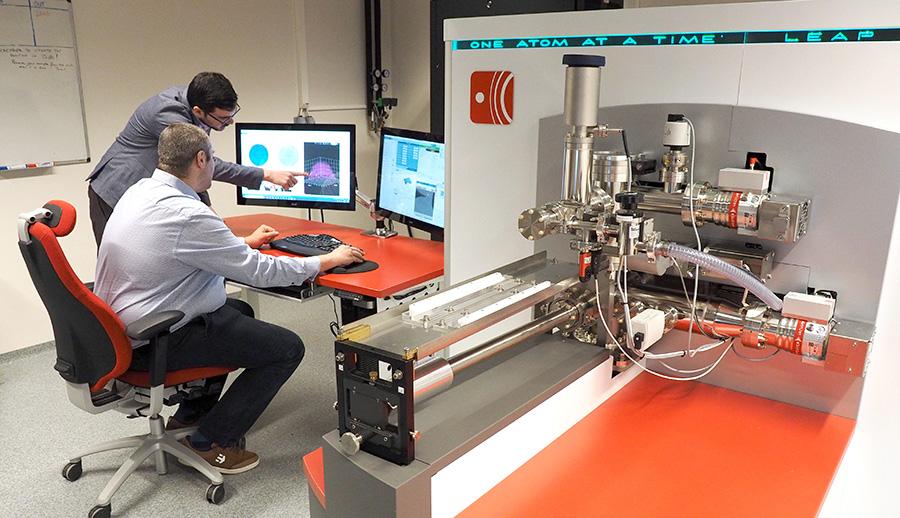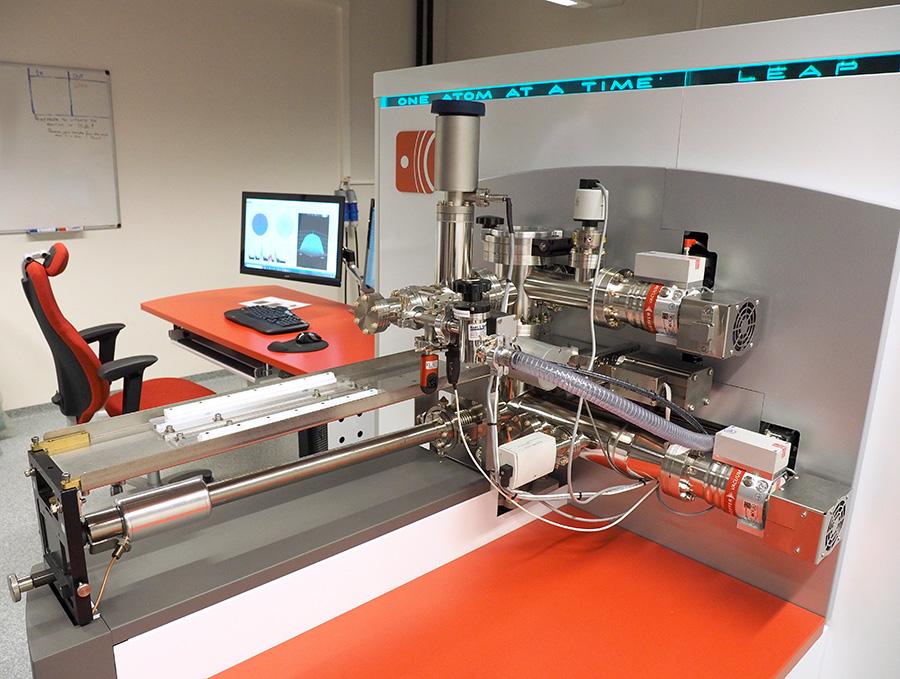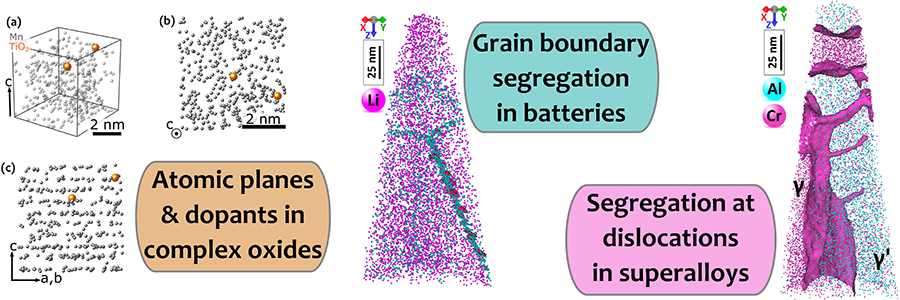Atom Probe Tomography (APT) - Department of Materials Science and Engineering
Atom Probe Tomography (APT)

Atom Probe Tomography (APT) is a microscopy method that is used to characterize materials by providing three-dimensional (3D) compositional imaging at near-atomic scale with high spatial and chemical sensitivity. APT is based on the field evaporation of atoms located at the surface of a sample that has previously been shaped into a sharp needle. The emitted atoms are detected using a time- and position-sensitive detector. As a time-of-flight mass spectrometry method, atoms are identified and their initial position within the structure of the material is reconstructed in 3D, following reconstruction algorithms.
The APT lab of NTNU is the first atom probe facility in Norway. It is a Norwegian national infrastructure, which was established in 2018 and funded by the Research Council of Norway (RCN) through the Norwegian Laboratory for Mineral and Materials Characterization (MiMaC) project. It is equipped with a Cameca 5000XS and it is located at the Department of Materials Science and Engineering. A wide range of materials are being analyzed using the APT facility at NTNU in various research and industrial projects. Projects involve materials from metallic materials such as superalloys and aluminium alloys, to batteries, oxides and minerals.
The APT lab has strong technical support from Dr. Constantinos Hatzoglou. Researchers who want to make use of the lab can receive support on planning their experiments and estimations on access costs required for their projects. As this is a national infrastructure, researchers and industries from all around the world can have access to the facility. You can simply contact us!
Since this is a national infrastructure, users have to acknowledge the contribution of the APT lab in any output, such as publications, master or PhD thesis, data etc., using the following statement: “The Research Council of Norway (RCN) is acknowledged for funding the NTNU atom probe facility through the Norwegian Laboratory for Mineral and Materials Characterization (MiMaC) project number 269842.”
2025
- I.-E. Nylund, E.R. Eilertsen, C.A. Hatzoglou, K.E. Aune, R. Bjørge, A.T.J. van Helvoort, A.M. Svensson, P. Kontis, Atomic-scale insights on grain boundary segregation in a cathode battery material, Scripta Materialia 269 (2025), 116905.
- J. Hamonnet, I.-E. Nylund, P. Kontis, W. Hua, P. Alonso-Sánchez, J.R. Zuazo, M.V. Blanco, A.M. Svensson, Degradation of LiNi0.5Mn1.5O4 cathodes in P111i4FSI ionic liquid electrolyte and carbonate electrolyte, ACS Applied Materials & Interfaces (2025).
- J. He, U. Ludacka, K.A. Hunnestad, D.R. Småbråten, K. Shapovalov, P.E. Vullum, C. Hatzoglou, D.M. Evans, E.D. Roede, Z. Yan, E. Bourret, S.M. Selbach, D. Gao, J. Akola, D. Meier, Local p- and n-Type Doping of an Oxide Semiconductor via Electric-Field-Driven Defect Migration, Advanced Science (2025) e06629.
- H.E.S. Linga, C. Hatzoglou, Y. Zhang, V. Brøtan, I. Westermann, X. Ren, B. Holmedal, Directed energy deposition of aluminium bronze onto H13 steel-microstructure in multi-material additive manufacturing, Materials Characterization 229 Part B, (2025) 115603.
- C. Li, C.D. Marioara, C. Hatzoglou, S.J. Andersen, R. Holmestad, Y. Li, Chemical composition dependent atom clustering during natural aging in Al-Mg-Si alloys, Scripta Materialia 257 (2025), 116474.
2024
- C. Li, C.D. Marioara, C. Hatzoglou, S.J. Andersen, R. Holmestad, Y. Li, Accelerating precipitation hardening by natural aging in a 6082 Al-Mg-Si alloy, Acta Materialia 281 (2024), 120396.
- B. Müller, G. Backes, W. Küppers, J. Kittel, N. Pirch, S. Hemes, M. Pedersen, C. Hatzoglou, P. Kontis, The effect of a laser-based heat treatment on the microstructure of a superalloy after a minimally invasive repair by direct energy deposition, 15th International Symposium on Superalloys 2024, Pennsylvania, USA
- A. Rapetti, A. Cervellon, E. Menou, J. Rame, F. Tancret, P. Kontis, Jonathan Cormier, Microstructural and thermomechanical assessment of computationally designed Ni-based SX superalloys, 15th International Symposium on Superalloys 2024, Pennsylvania, USA
- S. Shah, E. Thronsen, F. De Geuser, C. Hatzoglou, C. D Marioara, R. Holmestad, B. Holmedal, On the Use of a Cluster Identification Method and a Statistical Approach for Analyzing Atom Probe Tomography Data for GP Zones in Al–Zn–Mg(–Cu) Alloys, Microscopy and Microanalysis, Vol. 30, Issue 1, pages 1–13.
- K.A. Hunnestad, H. Das, C. Hatzoglou, M. Holtz, C.M. Brooks, A.T.J. van Helvoort, D.A. Muller, D.G. Schlom, J.A. Mundy, D. Meier, 3D oxygen vacancy distribution and defect-property relations in an oxide heterostructure, Nature Communications 15, (2024) 5400.
- J.A. Sørhaug, A. Elkjaer, E. Thronsen, T. Bergh, Ø. Grong, P.E. Vullum, R. Holmestad, Al-Cu intermetallic phase growth in hybrid metal extrusion & bonding welds exposed to isothermal annealing or direct current cycling, Materials & Design (2024) 240, 112867.
2023
- F. Flatscher, J. Todt, M. Burghammer, H.-S. Søreide, L. Porz, Y. Li, S. Wenner, V. Bobal, S. Ganschow, B. Sartory, R. Brunner, C. Hatzoglou, J. Keckes, D. Rettenwander, Deflecting Dendrites by Introducing Compressive Stress in Li7La3Zr2O12 Using Ion Implantation, Small (2023) 2307515.
- F. Han, X. Luo, Q. Liu, Z. Hou, K. Marthinsen, G.L. Wu, C. Hatzoglou, P. Kontis, X. Huang, The effect of grain size and rolling reduction on microstructure evolution and annealing hardening response of a Mg-3Gd alloy, Journal of Magnesium and Alloys (2023) In press.
- K.A. Hunnestad, C. Hatzoglou, F. Vurpillot, I.-E. Nylund, Z. Yan, E. Bourret, A.T.J. van Helvoort, D. Meier, Correlating laser energy with compositional and atomic-level information of oxides in atom probe tomography, Materials Characterization 203 (2023) 113085.
- E. Thronsen, S. Shah, C. Hatzoglou, C.D. Marioara, S. Wenner, S.J. Andersen, B. Holmedal, R. Holmestad, The evolution of precipitates in an Al–Zn–Mg alloy, Journal of Materials Research and Technology 23 (2023) 5666-5680.
- S. Wenner, C. Hatzoglou, E.A. Mørtsell, P. Åsholt, Clustering and precipitation during early-stage artificial aging of Al–Si–Mg(–Cu) foundry alloys, Metals 13 (2023) 557.
- C. Hatzoglou, G. Da Costa, P. Wells, X. Ren, B.P. Geiser, D.J. Larson, R. Demoulin, K. Hunnestad, E. Talbot, B. Mazumder, D. Meier, F. Vurpillot, Introducing a dynamic reconstruction methodology for multilayered structures in atom probe tomography, Microscopy and Microanalysis 29 (2023) 1124-1136.
- E.H. Bartawi, C.D. Marioara, G. Shaban, C. Hatzoglou, R. Holmestad, R. Ambat, Atomic structure of hardening precipitates in Al–Mg–Si alloys: Influence of minor additions of Cu and Zn, ACS Nano (2023), 17, 23, 24115–24129
- K.A. Hunnestad, J. Schultheiß, A.C. Mathisen, I.N. Ushakov, C. Hatzoglou, A.T.J. van Helvoort, D. Meier, Quantitative mapping of chemical defects at charged grain boundaries in a ferroelectric oxide, Advanced Materials (2023) Vol. 35, 38 2302543.
2022
- C. M. Hell, H.-S. Søreide, R. Bjørge, C. D. Marioara, Y. Li, R. Holmestad, Influence of Natural Aging and Ramping before Artificial Aging on the Microstructure of two different 6xxx Alloys, Journal of Materials Research and Technology 21 (2022) 4224-4240.
- E. Gadauskaite, K.A. Hunnestad, Q. N. Meier, D. Meier, M. Trassin, Ferroelectric domain engineering using structural defect ordering, Chem. Mater. 34 (2022) 14, 6468-6475.
- K.A. Hunnestad, C. Hatzoglou, Z. Khalid, P.E. Vullum, Z. Yan, E. Bourret, A.T.J. van Helvoort, S.M. Selbach, D. Meier, Atomic-scale 3D imaging of individual dopant atoms in an oxide semiconductor, Nature Communications 13 (2022) 4783.
- S. Shah, A. Gopal, E. Thronsen, C. Hatzoglou, B. Holmedal, Precipitation, mechanical properties and early slant ductile fracture in cyclic and naturally aged Al-Zn-Mg(-Cu) alloys, Materials & Design 222 (2022) 111026.
- S. Wu, H. S. Soreide, B. Chen, J. Bian, C. Yang, C. Li, P. Zhang, P. Cheng, J. Zhang, Y. Peng, G. Liu, Y. Li, H. J. Roven, J. Sun, Freezing solute atoms in nanograined aluminum alloys via high-density vacancies, Nature Communications 13 (2022) 3495.
- S. Shah, E. Thronsen, C. Hatzoglou, S. Wenner, C. D.Marioara, R. Holmestad, B. Holmedal, Effect of cyclic ageing on the early-stage clustering in Al–Zn–Mg(-Cu) alloys, Materials Science and Engineering: A 846 (2022) 143280.
2021
- A. Lervik, E. Thronsen, J. Friis, C. D. Marioara, S. Wenner, A. Bendo, K. Matsuda, R. Holmestad, S. J. Andersen, Atomic structure of solute clusters in Al–Zn–Mg alloys, Acta Materialia 205 (2021) 116574.
- J. K. Sunde, C. D. Marioara, S. Wenner, R. Holmestad, On the microstructural origins of improvements in conductivity by heavy deformation and ageing of Al-Mg-Si alloy 6101, Materials Characterization 176 (2021) 111073.
The APT lab is currently based at the Department of Materials Science and Engineering (Kjemi block 1) and it is equipped with a Cameca 5000XS. For APT sample preparation, the lab has electropolished facilities and established protocols for the preparation of samples when site-specific microstructures are not needed to be investigated. For site-specific sample preparation, we and other users use the dual beam Focused Ion Beam (FIB) microscopes located at the NTNU NanoLab.

Users that want to use the Nanolab, they will have to request access and training following the procedures of Nanolab. In coordination with the Nanolab, we will offer support on methods preparing APT samples using the FIB facilities. In addition, users can make use of a plasma FIB that was recently installed at NTNU outside of the Nanolab cleanroom and it is expected to be operational soon. For details about the PFIB you can contact Dr Hamid Khanmohammadi. Site-specific sample preparation also allow us to prepare APT samples for correlative TEM/APT studies, where users can benefit from the TEM facilities at the TEM Gemini Centre. The APT lab has all the necessary sample holders to perform correlative TEM/APT studies.
In the APT lab, users with various scientific questions seek to gain insights into different materials. APT provides a 3D compositional imaging at near atomic scale with high spatial and compositional resolution. That allow us to investigate for instance, segregation of solutes at grain boundaries and other crystal defects, such as dislocations, phase partitioning, cluster analysis and spatial mapping of trace elements or dopants. These are only a few examples of information that can be extracted from APT data.

For more information and organizing an experimental plan, please contact us. Examples of materials that we are currently working on, and not limited to, are superalloys, batteries, aluminium alloys, semiconductors and others.
The APT lab is located in the K1-building at Realfagbygget on campus Gløshaugen
Address
Sem Sælands vei 14
7034 Trondheim
Norway
Map by MazeMap
